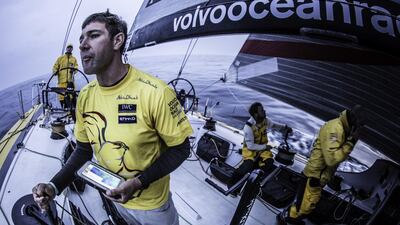A million decisions go into the winning of a Volvo Ocean Race. Many are made beforehand and a whole lot are made during each leg – based on cloud formations, weather and wind conditions, the state of the boat and not least, other boats.
Azzam's victory, confirmed after the final leg on Monday, was guided in no small degree by their navigator, Simon Fisher – known by his crewmates as Si-Fi – and, although he stressed it was the small decisions that ultimately secured the triumph, he revealed to The National five big decisions that made a difference.
Begin as you mean to end (Leg 1)
There was one critical decision, the first of the race, to go inside or outside the Cape Verde Islands as we were going down the North Atlantic. That was the first big split of the race, probably the biggest split we had all race.
It was an important one because it was early and being right set the tone for the race. We made the decision to go north as it put us on pretty strong footing to get through the Doldrums in the first leg. That dictates where you get to the Doldrums and where you get there dictates how you get out, so that worked well for us.
Leg placing: Winner
Current, not wind (Leg 2)
This was in the South Indian Ocean, going north past Madagascar. We were going downwind and a schedule came in and we found ourselves more separated from the fleet than we planned.
We were on our own and as things developed it looked like we had an opportunity to jump on the fleet and get ahead. But, as it turned out, we did the right thing by being very thorough in calibrating the currents data we had, because currents are as important as wind.
We spent a period trying to make sure the data was correct and once we realised it was we made a decision to join the fleet. If we did something different based on wind and not current, the second leg would’ve been much more difficult.
Leg placing: 3
Conquering the Southern Ocean (Leg 5)
The toughest leg and most challenging weather-wise. A key part of the decision making was when to push hard, when to be a bit more conservative. When we came into Cape Horn, we set the 24-hour speed record and set ourselves up well, going from fifth to second.
Going up the Atlantic, we saw a big storm coming from South America and that was probably the windiest conditions we saw in the race. We took the decision to not push so hard. Although we had built up a good lead we decided we would give up some miles but come out of it in good shape, with no boat damage.
When we got to Itajai we realised the damage other boats had and our gear looked in good shape. That was quite important as one of our long-term strategies was to look after our sails and make sure we didn’t have any breakages.
Leg placing: Winner
Bounce-back ability (Leg 6)
In the beginning we were unlucky, as it is always difficult in the South Atlantic. You get lots of storm clouds and reading clouds involves luck: you might get a good one, get ahead, and then a bad one and fall back.
Unfortunately for us a line of clouds dumped us from second to sixth. From that point, we were playing catch-up. But some good decision making helped us cut the deficit and then the subtlety of sailing came in. We made sure we had the right sail, found the fastest angle, chased the best winds, all the small decisions that added up. That is what got us back. It was a very rewarding leg because we worked our way back, got past boats. It’s hard on competitors when they see us grinding them down.
Leg placing: 2nd
Know your enemy (Leg 8)
This leg was the turning point. We approached this by wanting to mark the closest challengers to us (Dongfeng Race Team and Team Brunel) and then try, even if we didn’t win, to beat them.
Decision making was based on keeping an eye on them, to stay in front of one or both. We knew if one boat went one way we had to cover the other. As we crossed the Bay of Biscay with a lot of wind, Dongfeng went straight and headed north and Brunel headed east. We had to make a decision and we chose Brunel, mainly because it was closest to us.
In the end it was the right thing to do, even though the fleet got shuffled, we managed to keep those guys covered.
Leg position: 3rd
osamiuddin@thenational.ae
Follow us on Twitter @NatSportUAE

